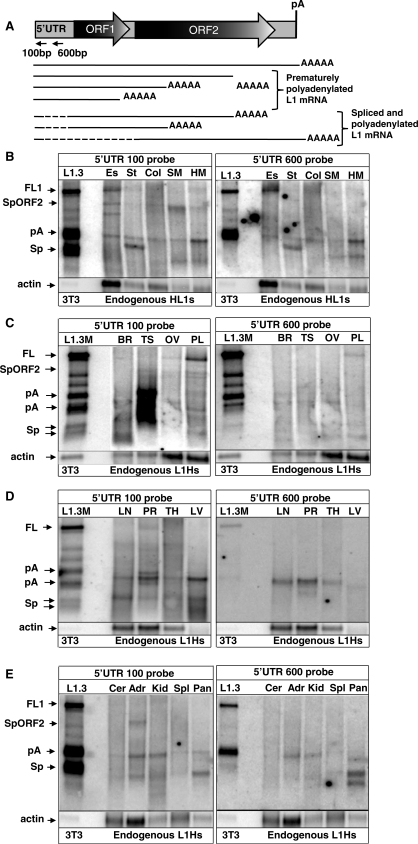Figure 1.
Endogenous L1 expression in normal human tissues. (A) A schematic representation of the L1 structure and some transcription products detected in normal tissues and cancer cells. Full-length L1 (FL1) element contains a 5′-UTR, two open reading frames 1 and 2 (ORF1 and 2), 3′-UTR and a polyadenylation signal (pA). L1 transcription results in the production of the full-length L1 (FL1) mRNA, prematurely polyadenylated mRNAs (pA), and spliced and polyadenylated mRNAs (Sp), one of which has the potential to express L1 ORF2 protein alone (SpORF2) as confirmed by its capability to mobilize Alu in a tissue culture assay (see Figure 4B). Dashed lines correspond to the L1 sequences that are removed by splicing. Horizontal arrows indicate relative positions of the strand-specific 5′-UTR 100 bp and 5′-UTR 600 bp probes used for northern blot analysis in this study. (B–E) Northern blot analysis of the endogenous L1 expression in various adult human tissues. Es, esophagus; St, stomach; Col, colon; SM, skeletal muscle; HM, heart muscle; Cer, cervix; Adr, adrenal gland; Kid, kidney; Spl, spleen; Pan, pancreas; Br, brain; Ts, testis; Ov, ovaries; Pl, placenta; LN, lung; PR, prostate; TH, thymus; LV, liver. The very left lane shows L1.3 wt (L1.3) and mutant (L1.3 M) that contains a mutation in the strongest polyA site (15) expression profiles in NIH 3T3 cells transiently transfected with these human L1 expression vectors. L1 transcription results in the production of the full-length L1 (FL1) mRNA, prematurely polyadenylated mRNAs (pA), and spliced and polyadenylated mRNAs (Sp) one of which has the potential to express L1 ORF2 protein (SpORF2). Actin denotes β-actin mRNA detected with a strand-specific probe.

